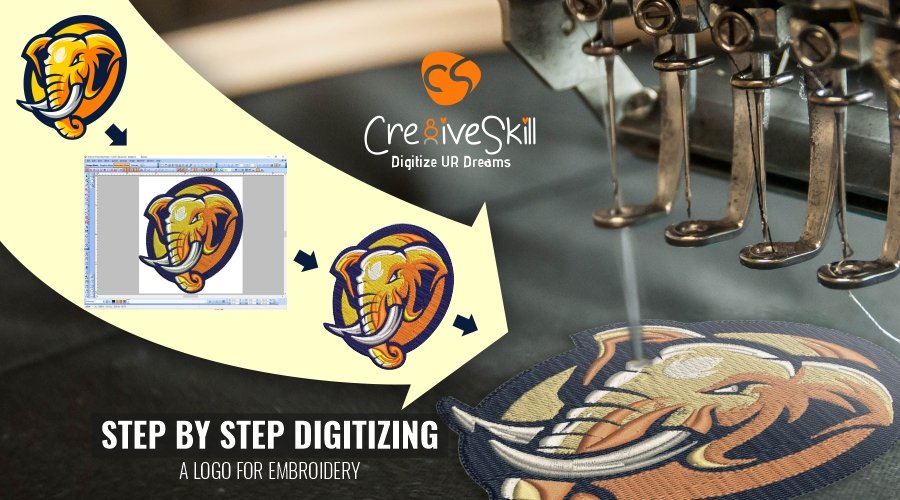Mastering the Needlework Digitizing Process: Your Ultimate Overview
Embroidery digitizing is a precise craft that needs accuracy and knowledge to equate intricate layouts into electronic styles for device embroidery. As artisans embark on this trip to master the embroidery digitizing procedure, a comprehensive understanding of the fundamentals establishes the structure for quality. However, beyond the simple expertise exists a realm of sophisticated software program, specialized devices, and nuanced techniques waiting to be explored. By delving right into the subtleties of digitizing, one can open a globe of creative possibilities and raise their needlework tasks to brand-new elevations.

Recognizing Needlework Digitizing Basics
Needlework digitizing essentials form the foundation upon which intricate designs are translated into machine-readable formats for precise stitching. This initial step in the needlework digitizing procedure is crucial for ensuring that the last stitched product is a devoted depiction of the initial style. Comprehending embroidery digitizing basics entails realizing vital principles such as stitch types, sew instructions, thickness, rug, and pull settlement.
Sew types play an important role in determining the aesthetic and textural result of the embroidered design. By selecting the appropriate stitch kind, whether it be satin, fill, or running stitch, digitizers can accomplish the desired result and boost the general quality of the needlework. Furthermore, stitch instructions affects the circulation and measurement of the design, while density establishes the spacing and insurance coverage of the stitches.
Additionally, underlay sewing offers security to the style by securing the textile and avoiding distortion during the needlework process. Draw compensation is another important consideration to neutralize the all-natural tendency of fabric to agreement when sewn. Grasping these needlework digitizing basics is fundamental for creating professional-quality stitched products.
Choosing the Right Digitizing Software Application
Picking the appropriate digitizing software application is an essential decision that considerably affects the efficiency and top quality of the embroidery digitizing process. Digitizing for Embroidery. When picking the right digitizing software, it is necessary to take into consideration factors such as the complexity of designs you prepare to create, the user-friendliness of the software application, the degree of client assistance supplied, and the compatibility with your needlework equipment
There are numerous digitizing software options available on the market, ranging from basic programs for novices to sophisticated software program for specialist digitizers. Some preferred selections consist of Wilcom EmbroideryStudio, Hatch Needlework Software Application, and PulseID. These software application bundles use a wide variety of devices and attributes to aid you develop intricate styles effortlessly.
Prior to deciding, it is advisable to discover the various software program alternatives with totally free trials or demos to determine which one best matches your demands. Additionally, reading testimonials and why not find out more looking for suggestions from skilled digitizers can give beneficial insights into the toughness and weaknesses of each software plan (Digitizing for Embroidery). By very carefully assessing your requirements and contrasting the attributes of different digitizing software, you can make an enlightened option that enhances your needlework digitizing workflow
Digitizing Devices and Methods

Optimizing Layout Setup for Needlework
Mastering the complexities of design setups is essential in attaining ideal results in the needlework digitizing process, structure upon the foundation laid by recognizing digitizing tools and strategies. When enhancing design setups for embroidery, it is important to consider factors such as stitch kind, thickness, underlay, draw settlement, and enrollment. Registration settings align different components of the style properly, maintaining total layout stability.

Troubleshooting Common Digitizing Issues
When encountering usual digitizing concerns throughout the needlework process, it is important to understand the origin triggers and carry out efficient options immediately. One typical trouble is stitch density problems, where stitches may be too thick, triggering the material to pucker, or too thin, bring about voids in the style. their explanation Readjusting the stitch density settings in the digitizing software program can aid solve this issue.
Another regular difficulty is thread breaks during the needlework procedure. This can take place because of various factors such as incorrect stress settings, plain needles, or using low-grade thread. Ensuring appropriate upkeep of the embroidery equipment, including routine needle adjustments and tension modifications, can lessen the event of string breaks.
In addition, design enrollment mistakes can result in misaligned aspects within the embroidery style. Checking the layout alignment in the digitizing software application and making necessary changes before stitching can aid in avoiding this concern. By resolving these common digitizing concerns quickly and successfully, you can ensure a smoother needlework process and top notch finished products.
Final Thought
Finally, understanding the needlework digitizing process requires a solid understanding of the essentials, the right option of software program, browse around this site and expertise of devices and techniques. Maximizing layout settings and troubleshooting common digitizing problems are crucial steps in making sure high-quality embroidery results. By following these actions faithfully, one can accomplish precision and effectiveness in the digitizing process.